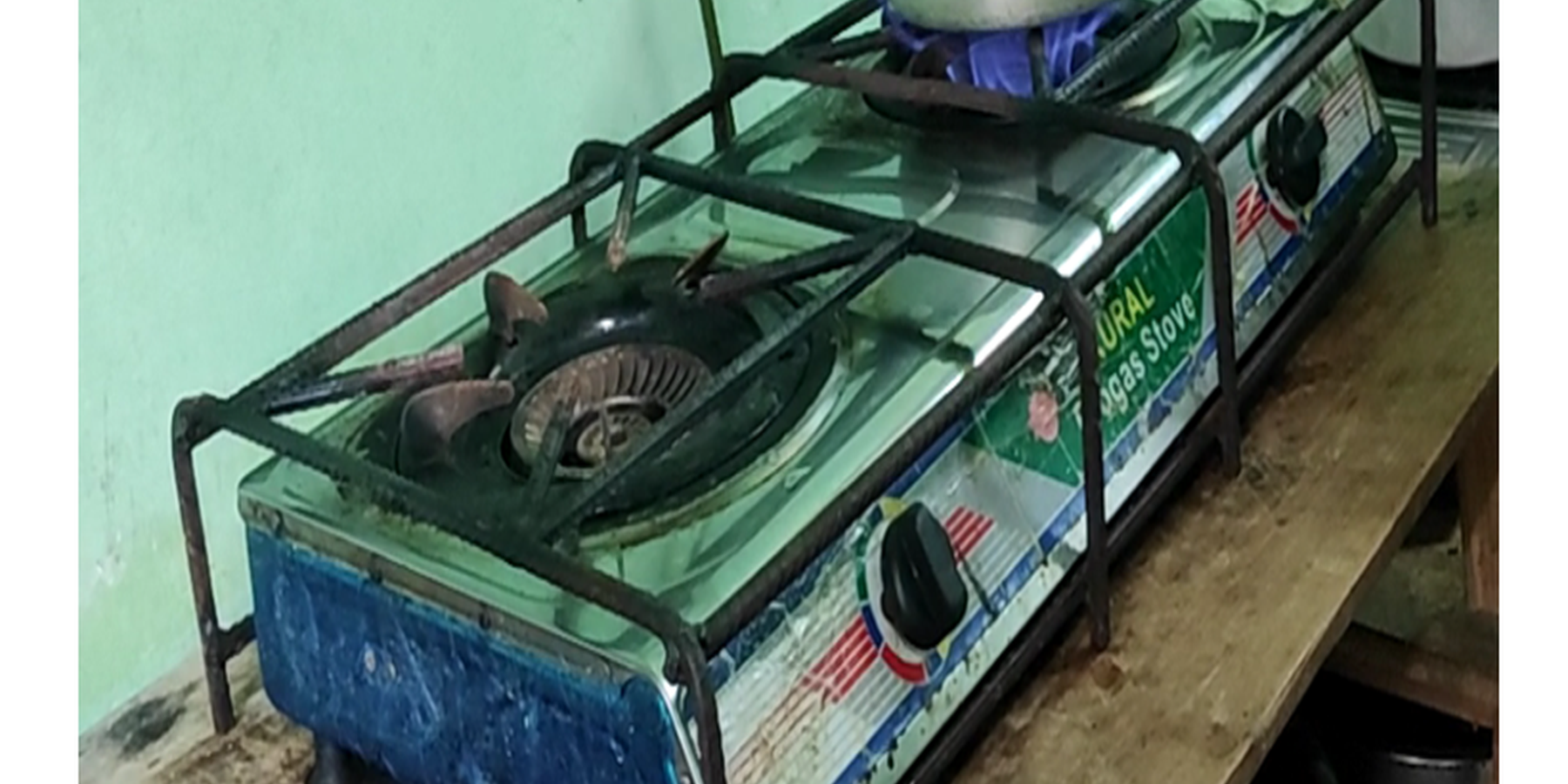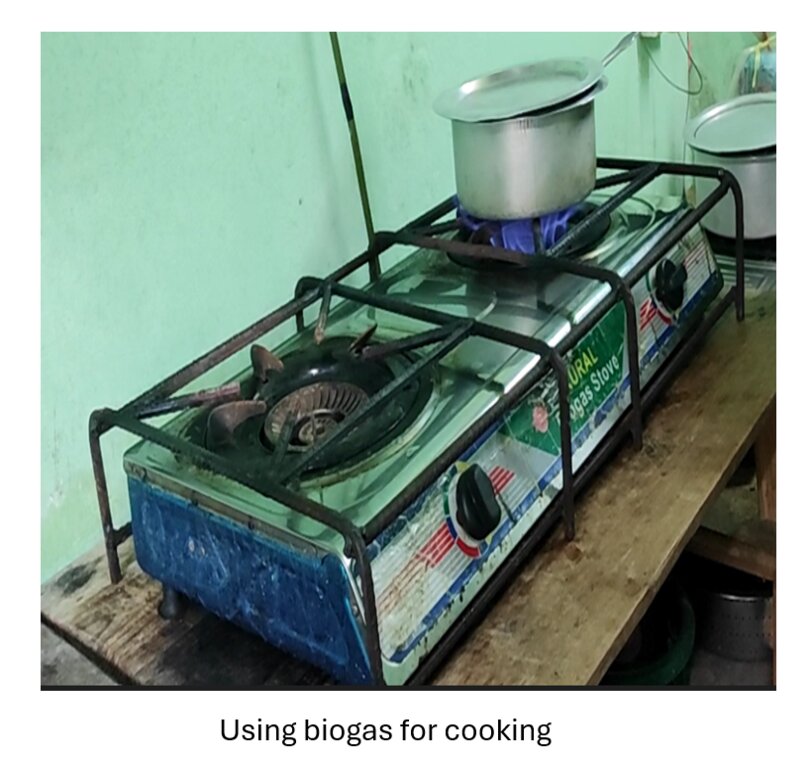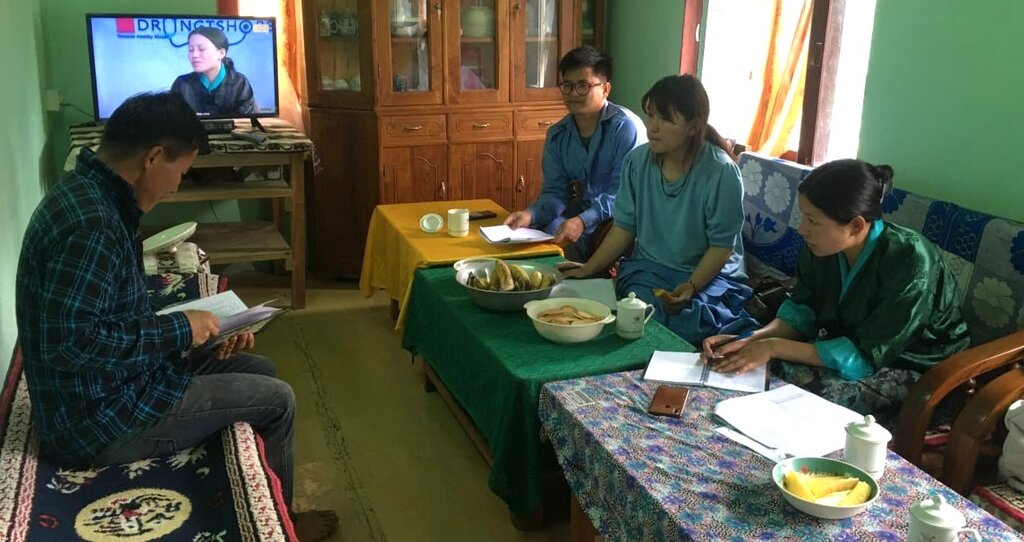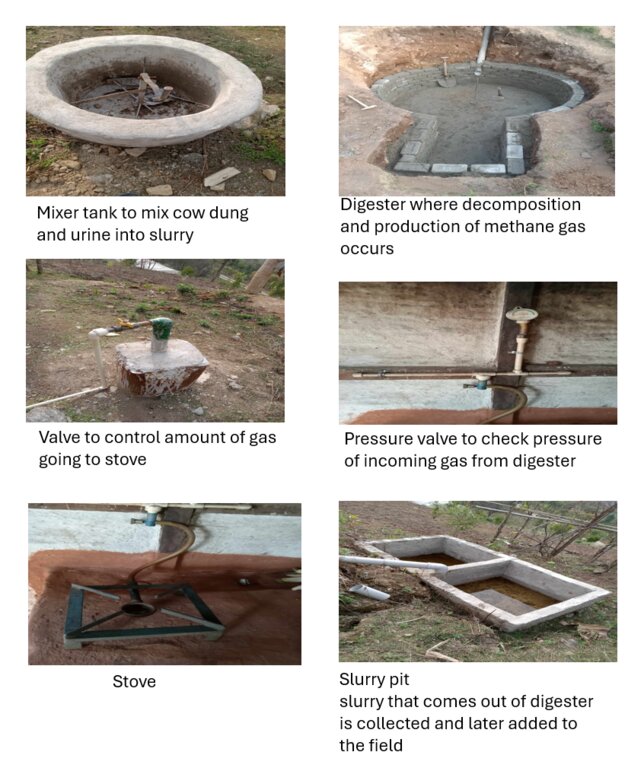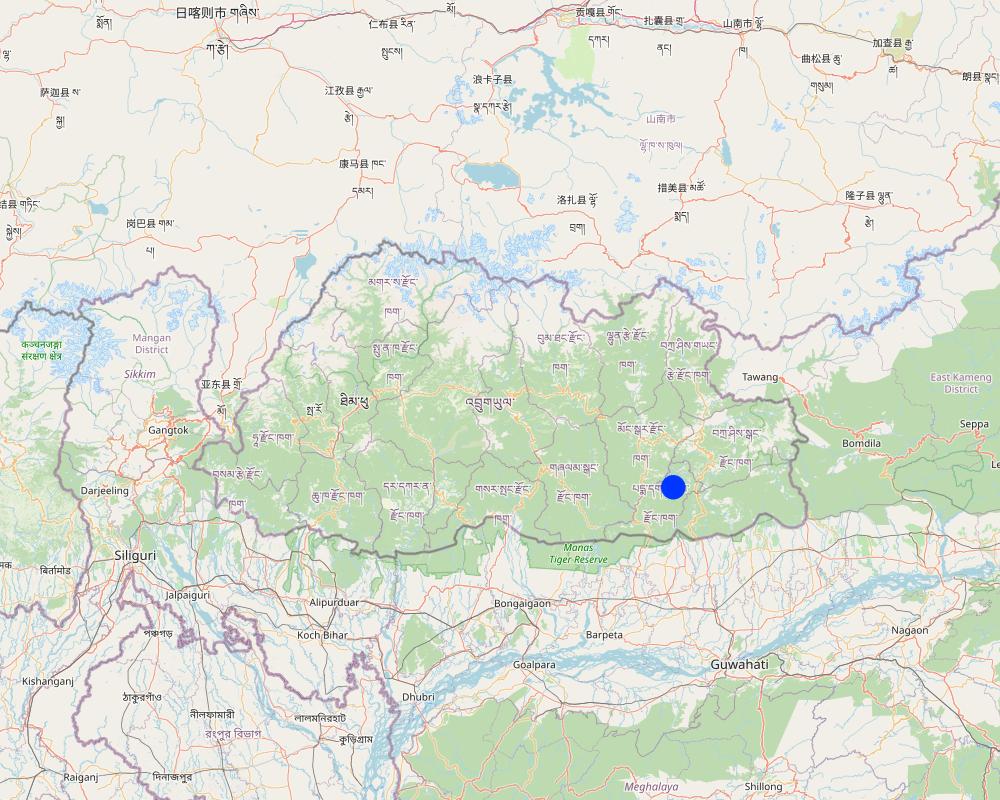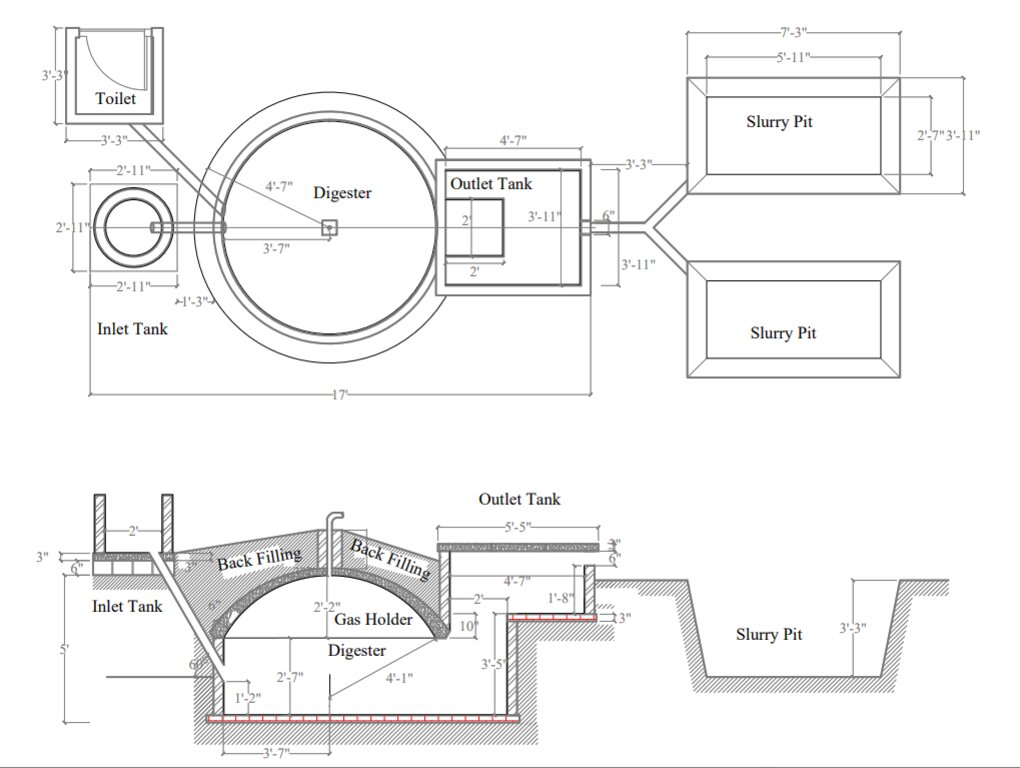Biogas plant [不丹]
- 创建:
- 更新:
- 编制者: ONGPO LEPCHA
- 编辑者: Tashi Wangdi
- 审查者: Rima Mekdaschi Studer, William Critchley
Kayden meylung (སྐྱེས་ལྡན་མེ་རླུང་༑)
technologies_6865 - 不丹
查看章节
全部展开 全部收起1. 一般信息
1.2 参与该技术评估和文件编制的资源人员和机构的联系方式
关键资源人
土地使用者:
Tshojay Rangsem
不丹
有助于对技术进行记录/评估的项目名称(如相关)
Strengthening national-level institutional and professional capacities of country Parties towards enhanced UNCCD monitoring and reporting – GEF 7 EA Umbrella II (GEF 7 UNCCD Enabling Activities_Umbrella II)有助于对技术进行记录/评估的机构名称(如相关)
National Soil Services Centre, Department of Agriculture, Ministry of Agriculture & Livestock (NSSC) - 不丹1.3 关于使用通过WOCAT记录的数据的条件
编制者和关键资源人员接受有关使用通过WOCAT记录数据的条件。:
是
1.4 所述技术的可持续性声明
这里所描述的技术在土地退化方面是否存在问题,导致无法被认为是一种可持续的土地管理技术?:
否
注释:
The technology involves the use of cattle dung in the production of energy which is used for cooking. Stall feeding is practiced for easy collection of cattle dung. Therefore, land degradation due to the movement of cattle and overgrazing in the forest is reduced.
2. SLM技术的说明
2.1 技术简介
技术定义:
Biogas is a renewable fuel generated through the anaerobic digestion of organic matter like food or animal waste, typically within a biogas plant. The biogas plant is adapted to household conditions and animal waste production. While this technology benefits small-scale farmers, challenges include the cost of establishment and the need for consistent waste input. Adoption has significantly reduced costs for users, lowered greenhouse gas emissions, and provided organic fertilizer, enhancing crop productivity and livestock health.
2.2 技术的详细说明
说明:
Biogas is a renewable fuel produced through the anaerobic digestion of organic matter, such as food or animal waste. Typically, biogas is intentionally generated in an enclosed environment (a biogas plant) for household consumption. This plant is constructed near a livestock shed for easy collection of animal waste and in proximity to households, mainly used for cooking, heating, and as an alternative to commercial LPG gas.
The plant can be adjusted based on the amount of animal waste, making it viable for smallholder farmers with just a few cows. In most parts of the country, the technology is modified so that even a small amount of animal waste can produce some gas. The digestion chamber is made smaller in diameter and height to generate enough pressure for the gas to reach the stove through the pipe. Initially, the Biogas project started to promote clean and renewable energy for household cooking, reducing the consumption of firewood. Currently, there are more than 8000 biogas plants of different sizes - 4 m3, 6 m3, 8 m3, and 10 m3, and a few large-scale biogas greater than 50 m3 in large individual dairy farms and government livestock farms.
The major activities and inputs required to establish and maintain the technology include having ample space around the residential area for the plant's construction. Additionally, materials such as cement, sand, gravel, stone, iron rods, pipes, pressure gauges, and a stove are necessary. Human resources are needed for the construction of the plant, and land users should have livestock (cows, buffaloes, horses, etc.) that can provide dung/waste for gas generation.
There are numerous benefits and impacts of the technology, including its positive effects on rural communities, greenhouse gas emission reduction, maintaining carbon neutrality, and minimizing the use of imported LPG gas and chemical fertilizers. It also reduces electricity bills needed for operating electric heaters, saving time for land users who would otherwise collect firewood. The by-product (bio-slurry) from the digester is used as organic fertilizer, enhancing crop productivity and serving as a nutritious feed supplement for animals.
Land users both appreciate and have concerns about the technology. They acknowledge the cost reduction benefits, citing the significant savings compared to market-priced commercial LPG gas and reduced expenses on operating electric heaters. The technology has also provided them with additional time by eliminating the need to gather firewood. The bio-slurry, a by-product of the biodigester, serves as fertilizer to enhance crop production and contributes to livestock waste management, improving livestock health and production.
However, land users note that biogas plant establishment is expensive and may not be suitable for economically disadvantaged individuals. Some users experience challenges, such as the biodigester chamber failing to produce enough gas despite being constructed according to technical specifications. The daily requirement of adding animal waste to the input tank is perceived as tedious, and for land users with only one or two milking cows, supplying the required amount of animal waste for the biodigester chamber is often a problem.
2.3 技术照片
2.5 已应用该技术的、本评估所涵盖的国家/地区/地点
国家:
不丹
区域/州/省:
Shumar Gewog (Block), Pemagatshel Dzongkhag (District)
有关地点的进一步说明:
Darchung under Shumar Chiwog (Community)
具体说明该技术的分布:
- 适用于特定场所/集中在较小区域
技术现场是否位于永久保护区?:
否
注释:
Biogas technology is used mainly for cooking and heating at the household level.
Map
×2.6 实施日期
注明实施年份:
2021
2.7 技术介绍
详细说明该技术是如何引入的:
- 通过项目/外部干预
注释(项目类型等):
Biogas technology was introduced as part of the Bhutan Biogas project under the then Department of Renewable Energy, Ministry of Economic Affairs and the Department of Livestock, Ministry of Agriculture and Livestock, Thimphu.
3. SLM技术的分类
3.1 该技术的主要目的
- 改良生产
- 减缓气候变化及其影响
- 创造有益的经济影响
- The main purpose as discussed by the land user was to reduce the cost and effort invested in getting LPG. Getting LPG was difficult becuase of the distance.
3.2 应用该技术的当前土地利用类型
同一土地单元内混合使用的土地::
是
具体说明混合土地使用(作物/放牧/树木):
- 农林牧业

农田
- 一年一作
- 多年一作(非木材)
- 乔木与灌木的种植
- French bean, Potato, Onion, Chili, Cole crop (Cabbage, broccoli, Cauliflowers), Mustard green, etc.
- Avocado, Banana, Grapes, Mango, Papaya, Pomegranate, Pear
每年的生长季节数:
- 3
具体说明:
Maize(fodder) is followed by vegetable like beans, which is again followed by Cole crops.
采用间作制度了吗?:
否
采用轮作制度了吗?:
是
如果是,请具体说明:
Maize(fodder) is followed by vegetable like beans, which is again followed by Cole crops (Cabbage).

牧场
- Land user allow six months of grazing in pasture land. Six months cattle are stall fed.
- Land user had eight cows which were all Jersey breed.
是否实行作物与牲畜的综合管理?:
是
如果是,请具体说明:
Crop residue is used as feed, and cow dung as manure to improve soil fertility.
产品和服务:
- economic security, investment prestige
- manure as fertilizer/ energy production
- 奶类
品种:
牛 - 奶制品
计数:
8
3.3 由于技术的实施,土地使用是否发生了变化?
由于技术的实施,土地使用是否发生了变化?:
- 否(继续问题3.4)
3.4 供水
该技术所应用土地的供水:
- 混合雨水灌溉
注释:
In rainy seasons irrigation supplies are disturbed frequently, In such cases land users depend on rainwater for animals and irrigation.
3.5 该技术所属的SLM组
- 农畜综合管理
- 废物管理/废水管理
- 节能技术
3.6 包含该技术的可持续土地管理措施

结构措施
- S9:动植物庇护所
- S10:节能措施
3.7 该技术强调的主要土地退化类型

物理性土壤退化
- Pu:由于其他活动而导致生物生产功能的丧失
注释:
Stall feeding can reduce land degradation by controlling movement of cow from one place to another. Dung is used for generation of fuel energy, and the waste produced after gas production, is applied to improve fertility of the land.
3.8 防止、减少或恢复土地退化
具体数量名该技术与土地退化有关的目标:
- 防止土地退化
- 减少土地退化
注释:
Stall feeding reduces land degradation that can occur from the movement of cows from one place to another. Growing of fodder species like Napier grass, Guatemala grass, Pakchong (Super Napier), and Ruzi grass can prevent land degradation.
4. 技术规范、实施活动、投入和成本
4.1 该技术的技术图纸
技术规范(与技术图纸相关):
Technical design and specification of 4 cubic meter biogas plant capacity
作者:
Bhutan Biogas Project, Department of Livestock, Ministry of Agriculture & Livestock
4.2 有关投入和成本计算的一般信息
具体说明成本和投入是如何计算的:
- 每个技术单元
指定单位:
inlet tank (mixing tank), inlet pipes, Digester, gas holder, manhole, outlet, main gas pipe turret, main gas valve, pipeline, water outlet, pressure gauge, gas tab, gas stove, gas lamp, slurry pit
指定单位面积(如相关):
Dimensions of unit is given in technical diagram.
其它/国家货币(具体说明):
Bhutanese Ngultrum
如相关,注明美元与当地货币的汇率(例如1美元=79.9巴西雷亚尔):1美元=:
82.73
注明雇用劳工的每日平均工资成本:
Nu 350
4.3 技术建立活动
| 活动 | 时间(季度) | |
|---|---|---|
| 1. | Selection of construction site and layout of the plant | 1st March |
| 2. | Digging of pits | 15th April |
| 3. | construction of digester | May |
| 4. | construction of gas holder (dome) | May |
| 5. | Plastering of Digester and gas holder | May |
| 6. | construction of turret, manhole and outlet tank | May |
| 7. | Construction of Inlet Tank | June |
| 8. | Fitting pipelines and appliances | June |
| 9. | Construction of compost pit | June |
| 10. | Finishing and instruction to users | July |
注释:
The land user could not mention the exact date for the initiation and completion of some activities. However, most activities were completed within May-June month.
4.4 技术建立所需要的费用和投入
| 对投入进行具体说明 | 单位 | 数量 | 单位成本 | 每项投入的总成本 | 土地使用者承担的成本% | |
|---|---|---|---|---|---|---|
| 劳动力 | Labour | person-days | 18.0 | 350.0 | 6300.0 | |
| 劳动力 | Masion | person-days | 12.0 | 1000.0 | 12000.0 | |
| 设备 | Mixture machine | no | 1.0 | 1740.0 | 1740.0 | |
| 设备 | GI nozzle | no | 1.0 | 113.0 | 113.0 | |
| 植物材料 | water draining pipe | no | 1.0 | 262.0 | 262.0 | |
| 植物材料 | Main gas valve | no | 1.0 | 523.0 | 523.0 | |
| 植物材料 | Paint brush | no | 1.0 | 85.0 | 85.0 | |
| 植物材料 | Iron brush | no | 1.0 | 85.0 | 85.0 | |
| 植物材料 | CPVC glue (50gm) | Jar | 1.0 | 390.0 | 390.0 | |
| 植物材料 | Teflon tape | roll | 1.0 | 25.0 | 25.0 | |
| 植物材料 | PVC pipe 4"10' (inlet) | no | 1.0 | 1050.0 | 1050.0 | |
| 施工材料 | Cement | Bag | 18.0 | 380.0 | 6840.0 | |
| 施工材料 | Bricks | No | 1000.0 | 11.0 | 11000.0 | |
| 施工材料 | Gravels | Truckload | 0.5 | 5000.0 | 2500.0 | |
| 施工材料 | Sand | Truckload | 0.25 | 6000.0 | 1500.0 | |
| 施工材料 | Arcrylic paint | litres | 3.0 | 350.0 | 1050.0 | |
| 施工材料 | Iron rod | kg | 10.0 | 70.0 | 700.0 | |
| 施工材料 | Dome pipe | No | 1.0 | 1170.0 | 1170.0 | |
| 其它 | Stove | No | 1.0 | 1399.0 | 1399.0 | |
| 其它 | CPVC Pipe (10') | No | 10.0 | 350.0 | 3500.0 | |
| 其它 | Gas tap | No | 1.0 | 465.0 | 465.0 | |
| 其它 | Pressure meter | No | 1.0 | 320.0 | 320.0 | |
| 其它 | Elbow joint | No | 4.0 | 350.0 | 1400.0 | |
| 其它 | T - union | No | 2.0 | 150.0 | 300.0 | |
| 技术建立所需总成本 | 54717.0 | |||||
| 技术建立总成本,美元 | 661.39 | |||||
如果您无法分解上表中的成本,请估算建立该技术所需要的总成本。:
50000.0
如果土地使用者负担的费用少于100%,请注明由谁负担其余费用:
Raw material for construction of the plant was supported by the government.
注释:
18 bags of cement, iron rods, pipes, a pressure gauge, and a stove were supported by government.
4.5 维护/经常性活动
注释:
It was a new plant so the land user did not mention anything on maintenance.
4.7 影响成本的最重要因素
描述影响成本的最决定性因素:
Raw materials, transportation cost, labour charges.
5. 自然和人文环境
5.1 气候
年降雨量
- < 250毫米
- 251-500毫米
- 501-750毫米
- 751-1,000毫米
- 1,001-1,500毫米
- 1,501-2,000毫米
- 2,001-3,000毫米
- 3,001-4,000毫米
- > 4,000毫米
农业气候带
- 半湿润
The study area is located in sub humid area
5.2 地形
平均坡度:
- 水平(0-2%)
- 缓降(3-5%)
- 平缓(6-10%)
- 滚坡(11-15%)
- 崎岖(16-30%)
- 陡峭(31-60%)
- 非常陡峭(>60%)
地形:
- 高原/平原
- 山脊
- 山坡
- 山地斜坡
- 麓坡
- 谷底
垂直分布带:
- 0-100 m a.s.l.
- 101-500 m a.s.l.
- 501-1,000 m a.s.l.
- 1,001-1,500 m a.s.l.
- 1,501-2,000 m a.s.l.
- 2,001-2,500 m a.s.l.
- 2,501-3,000 m a.s.l.
- 3,001-4,000 m a.s.l.
- > 4,000 m a.s.l.
说明该技术是否专门应用于:
- 不相关
5.3 土壤
平均土层深度:
- 非常浅(0-20厘米)
- 浅(21-50厘米)
- 中等深度(51-80厘米)
- 深(81-120厘米)
- 非常深(> 120厘米)
土壤质地(表土):
- 粗粒/轻(砂质)
- 细粒/重质(粘土)
土壤质地(地表以下> 20厘米):
- 中粒(壤土、粉土)
表土有机质:
- 高(>3%)
5.4 水资源可用性和质量
水质(未处理):
良好饮用水
水质请参考::
地表水
水的盐度有问题吗?:
否
该区域正在发生洪水吗?:
是
规律性:
偶然
关于水质和水量的注释和进一步规范:
Recently, staff from the Ministry of Health tested the water quality, and the land user told that the water is good and drinkable.
5.5 生物多样性
物种多样性:
- 高
栖息地多样性:
- 高
关于生物多样性的注释和进一步规范:
Land users have planted almost all fruit trees, fooder species, annual crops, perennial vegetables like asparagus, etc., which indicated high species and habitat diversity.
5.6 应用该技术的土地使用者的特征
定栖或游牧:
- 定栖的
生产系统的市场定位:
- 混合(生计/商业)
非农收入:
- 低于全部收入的10%
相对财富水平:
- 丰富
个人或集体:
- 个人/家庭
机械化水平:
- 手工作业
性别:
- 男人
土地使用者的年龄:
- 中年人
说明土地使用者的其他有关特征:
The land user's age at the time of the interview was 45 years old.
5.7 应用该技术的土地使用者使用的平均土地面积
- < 0.5 公顷
- 0.5-1 公顷
- 1-2 公顷
- 2-5公顷
- 5-15公顷
- 15-50公顷
- 50-100公顷
- 100-500公顷
- 500-1,000公顷
- 1,000-10,000公顷
- > 10,000公顷
这被认为是小规模、中规模还是大规模的(参照当地实际情况)?:
- 中等规模的
注释:
According to the Land Act of Bhutan 2007. The maximum land ceiling per family is 25 acres, However, in Bhutan majority of land users are medium-scale i.e., less than 3 acres.
5.8 土地所有权、土地使用权和水使用权
土地所有权:
- 个人,有命名
土地使用权:
- 个人
用水权:
- 社区(有组织)
土地使用权是否基于传统的法律制度?:
是
5.9 进入服务和基础设施的通道
健康:
- 贫瘠
- 适度的
- 好
教育:
- 贫瘠
- 适度的
- 好
技术援助:
- 贫瘠
- 适度的
- 好
就业(例如非农):
- 贫瘠
- 适度的
- 好
市场:
- 贫瘠
- 适度的
- 好
能源:
- 贫瘠
- 适度的
- 好
道路和交通:
- 贫瘠
- 适度的
- 好
饮用水和卫生设施:
- 贫瘠
- 适度的
- 好
金融服务:
- 贫瘠
- 适度的
- 好
注释:
The hospital is located 10 km away from Land users' places. Which makes it a little difficult during emergencies. The school is 2 Km away which is very near. There are also Gypsum Mining which provides off-farm activities to many land user in the locality. The land user is trained in making Biogas plants, this also provides him the opportunity to work off-farm. When it comes to energy, apart from energy to light the house, energy is required for cooking purposes. This energy was previously derived from LPG, however, after the Biogas plant land user is not having any difficulties with energy shortage. Land users have their own water source and the same water is used to feed Jersey cows. Land users also said that they get financial assistance from Bhutan Development Bank Limited.
6. 影响和结论性说明
6.1 该技术的现场影响
社会经济效应
生产
作物生产
注释/具体说明:
Land users didn't keep a record of the production, however, it was reported that crop production has improved.
作物质量
注释/具体说明:
land users reported that crops are healthier and green when manure prepared from cow dung/ biogas plants is applied on the land.
饲料生产
注释/具体说明:
Land user is also members of milk cooperatives. He maintains different fodder species to have feed for his cows throughout the years. He said fodder production has increased over the years.
饲料质量
注释/具体说明:
Different species of fodder species like Napier, Ruzi, Guatemala, Super Napier, Banana, Rice straw, maize, and fooder tree species like Ficus auriculata, Ficus simicordata, etc., were observed.
能源生产
SLM之前的数量:
6 LPG cylinder per annum
SLM之后的数量:
0
注释/具体说明:
Each LPG cost around Nu. 1000. LPG is completely replaced by biogas technology.
水资源可用性和质量
饮用水的质量
注释/具体说明:
Water was not a problem from the beginning. However, with an improved breed of cow (jersey), water sanitation is also given more importance. Because water can bring diseases to family members and livestock.
收入和成本
农业收入
注释/具体说明:
Land user don't have to buy LPG cylinders. He saves around 7000 in a year.
工作量
注释/具体说明:
Workload has increased since the biogas plant was constructed. Every day the land user have to collect cow dung and add it to the plant. He also has to collect slurry and add to the land to improve fertility.
6.2 该技术的场外影响已经显现
温室气体的影响
注释/具体说明:
Scope to conduct research to estimate GHG emission reduction from biogas technology
6.3 技术对渐变气候以及与气候相关的极端情况/灾害的暴露和敏感性(土地使用者认为的极端情况/灾害)
渐变气候
渐变气候
| 季节 | 增加或减少 | 该技术是如何应对的? | |
|---|---|---|---|
| 年温度 | 增加 | 好 | |
| 季节性温度 | 夏季 | 增加 | 好 |
| 年降雨量 | 增加 | 好 | |
| 季雨量 | 夏季 | 增加 | 好 |
6.4 成本效益分析
技术收益与技术建立成本相比如何(从土地使用者的角度看)?
短期回报:
非常积极
长期回报:
非常积极
技术收益与技术维护成本/经常性成本相比如何(从土地使用者的角度看)?
短期回报:
非常积极
长期回报:
非常积极
注释:
The investment cost is shared by the Government. Therefore, the land users felt the benefits are very positive.
6.5 技术采用
- 11-50%
如若可行,进行量化(住户数量和/或覆盖面积):
Only two households were interviewed, alothough, there are more than 300 households who have adopted biogas technology under study area (Shumar Gewog).
在所有采用这项技术的人当中,有多少人是自发的,即未获得任何物质奖励/付款?:
- 0-10%
注释:
The biogas technology was initiated and promoted by the Department of Livestock and Department of Renewable Energy in Bhutan on a cost-sharing basis.
6.6 适应
最近是否对该技术进行了修改以适应不断变化的条件?:
否
6.7 该技术的优点/长处/机会
| 土地使用者眼中的长处/优势/机会 |
|---|
| Land user need not buy LPG cylinders because the Biogas plant |
| No need to go to collect firewood |
| 编制者或其他关键资源人员认为的长处/优势/机会 |
|---|
| Efficient use of livestock (cow dung) for generation energy which is used for cooking. |
| The technology is not easily damaged by pests, temperature, rainfall, etc. |
6.8 技术的弱点/缺点/风险及其克服方法
| 土地使用者认为的弱点/缺点/风险 | 如何克服它们? |
|---|---|
| Cow dung has to be collected, and put into a mixing tank and mixing has to be done manually which is hectic. | |
| A huge amount of cow dung is required. |
| 编制者或其他关键资源人员认为的弱点/缺点/风险 | 如何克服它们? |
|---|---|
| Sometimes, despite good construction material, small calculations in biodigester and gas compartments can lead to a technical error, and this can inhibit gas production. In such cases, the biogas plant becomes nonfunctional. | Being extra careful with the design and consulting the biogas focal person to monitor the construction work. |
| Low temperature has a deleterious effect on methanogenesis and can cause decreased gas yields. So the technology may not work effectively in winter. | Maintaining the temperature by covering the tank with warm material. |
7. 参考和链接
7.1 信息的方法/来源
- 实地考察、实地调查
1
- 与土地使用者的访谈
1
- 与SLM专业人员/专家的访谈
1
- 根据报告和其他现有文档进行编译
5
(现场)数据是什么时候汇编的?:
13/07/2023
7.2 参考可用出版物
标题、作者、年份、ISBN:
Domestic Biogas Implementation Guidelines, Departement of Renewable Energy, Ministry of Economic Affairs, 2020
可以从哪里获得?成本如何?
Online (free)
标题、作者、年份、ISBN:
Case study Green Growth Initiative in Bhutan: Bhutan Biogas Project, Chris Oestereich, 2018.
可以从哪里获得?成本如何?
Online (free)
7.3 链接到网络上的相关信息
标题/说明:
Case Study on Green Growth Initiative in Bhutan: Bhutan Biogas Project by Chris Oestereich,
URL:
https://sdghelpdesk.unescap.org/sites/default/files/2018-03/GG%20-%20Bhutan%20Biogas%20Project.pdf
标题/说明:
Biogas Project Overview: Bhutan, Dawa Penjor Dawa Zam (presentation)
URL:
https://www.saarcenergy.org/wp-content/uploads/2016/07/Bhutan%20presentation.pdf
标题/说明:
Biogas system at household level fed daily with cattle manure [Cambodia]
URL:
https://qcat.wocat.net/wocat/technologies/view/technologies_1645/
标题/说明:
Domestic Biogas Plant for Fuel and fertilizer[Uganda]
URL:
https://qcat.wocat.net/wocat/technologies/view/technologies_3371/
7.4 一般注释
Some questions in the questionnaire are not applicable to Bhutan, However, we tried to provide the best information possible.
链接和模块
全部展开 全部收起链接
无链接
模块
无模块


